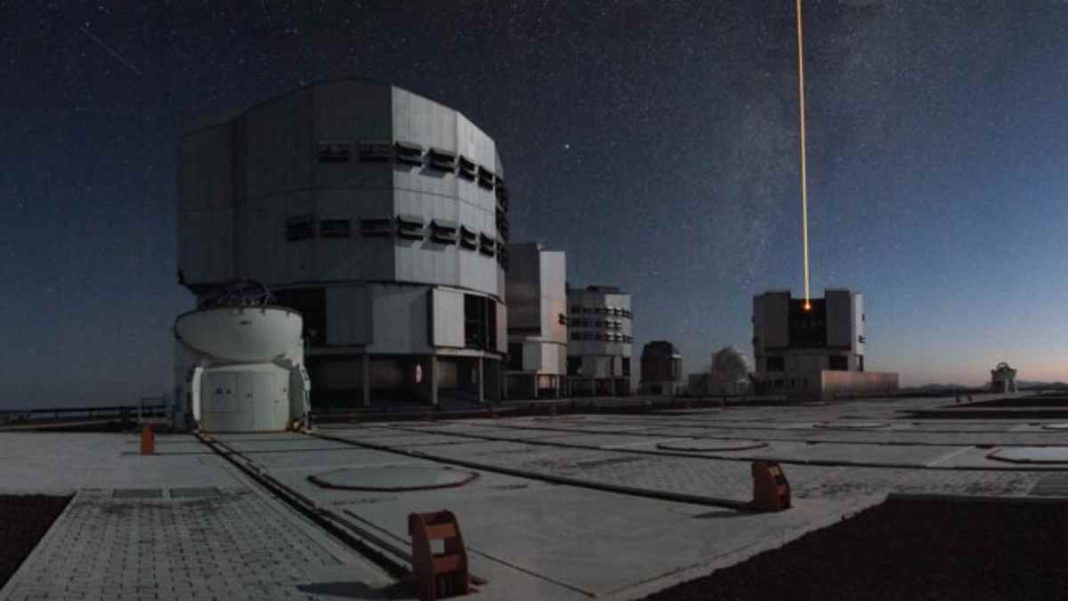GERMANY: In a groundbreaking collaboration involving a dozen cutting-edge telescopes, both ground-based and space-borne, including three facilities from the European Southern Observatory (ESO), astronomers have finally unraveled the perplexing behavior of a pulsar—a super-fast-spinning dead star. This remarkable achievement has shed light on the mysterious alternating brightness modes that have baffled scientists for years.
A pulsar, a celestial corpse that rotates at astonishing speeds, emits a focused beam of electromagnetic radiation into space, akin to a lighthouse beam scanning its surroundings. This emitted radiation becomes visible to astronomers as it crosses Earth’s line of sight, giving rise to the star’s characteristic pulsating brightness.
The subject of this scientific breakthrough is the pulsar known as PSR J1023+0038, or simply J1023. Positioned approximately 4500 light-years away in the Sextans constellation, J1023’s peculiar behavior has left scientists scratching their heads. Notably, the pulsar switches between two distinct brightness modes at an almost constant rate—a phenomenon that has remained a mystery until now.
A recent research paper published in Astronomy & Astrophysics, led by Maria Cristina Baglio, a researcher at New York University Abu Dhabi and affiliated with the Italian National Institute for Astrophysics (INAF), reveals the astonishing discoveries made through an unparalleled observational campaign.
This endeavor involved a constellation of telescopes, including ESO’s Very Large Telescope (VLT), ESO’s New Technology Telescope (NTT), and the Atacama Large Millimeter/Submillimeter Array (ALMA), a collaborative effort in which ESO is a partner. Over the course of two nights in June 2021, the team witnessed J1023 switch modes more than 280 times.
J1023, which orbits closely with another star, has been actively accreting matter from its companion over the past decade. This accumulated matter forms a disc around the pulsar, gradually spiraling towards it.
As this process unfolded, the pulsar’s sweeping radiation beam all but disappeared, replaced by an incessant toggling between the high and low brightness modes.
In the high mode, the pulsar emits intense X-rays, ultraviolet, and visible light, while the low mode is characterized by dimmer radiation at these frequencies and an increase in radio waves.
Francesco Coti Zelati, co-lead author of the study and a researcher at the Institute of Space Sciences in Barcelona, Spain, underscores the complexity of the phenomenon. The team’s analysis revealed that the switching behavior arises from a delicate interplay between the pulsar’s wind—a flow of high-energy particles streaming away from the pulsar—and the matter moving towards it.
In the low mode, matter heading for the pulsar is expelled in a focused jet perpendicular to the disc. As the matter accumulates closer to the pulsar, it interacts with the wind generated by the rapidly spinning star, causing it to heat up and transition into high mode. Eventually, blobs of this heated matter are expelled from the system, leading it back to low mode.
Sergio Campana, Research Director at the INAF Brera Observatory and a coauthor of the study, looks ahead to future discoveries. ESO’s upcoming Extremely Large Telescope (ELT), presently under construction in Chile, is poised to offer unprecedented insights into the mechanisms behind J1023’s mode switching.
Campana emphasizes that the ELT will provide crucial information about how the inflowing matter around the pulsar—its abundance, distribution, dynamics, and energy—responds to the switching behavior.
Also Read: Countdown to History: NASA’s OSIRIS-REx Prepares to Land Precious Asteroid Sample on Earth



